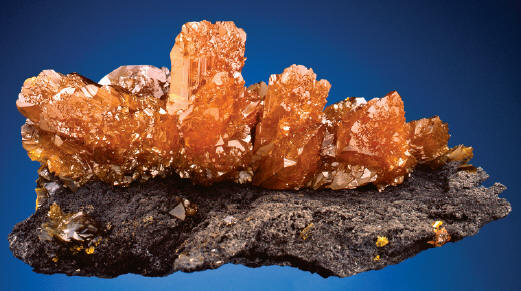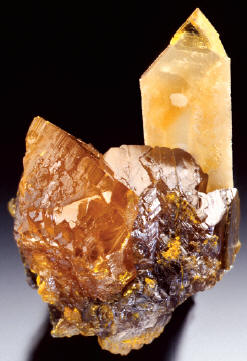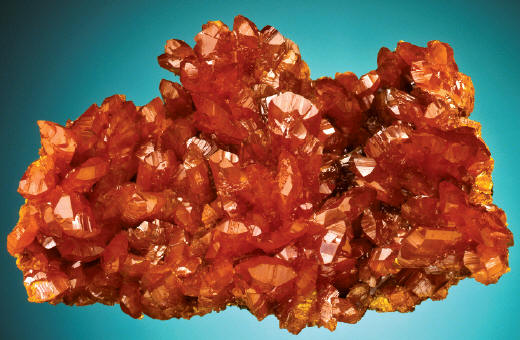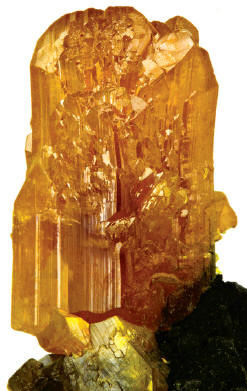Author: Scott KLEINE, Bryan K. LEES & Malcolm SOUTHWOOD Date: 2014-9-7 20:15:12
SPECIMEN PREPARATION
Experiments commenced at the Collector’s Edge laboratories in Golden, Col- orado, in May 1999 to determine the bestmethods for specimen preparation. Aftermany tests, it became clear that heavycoatings could not be removed withoutdamaging the luster of the crystals. Furthermore ,specimens with any degree ofnatural etching could not be improved.

Orpiment from Cut 62; 9.5 cm wide. Collector’s Edge specimen. J. Scovil photo.
Some specimens were coated with, orpartly included by, an unattractive graybrownmaterial that left them unpleasingto the eye. Indeed, were it not for suchcoatings, the number of recoverablespecimens would have been very muchhigher – possibly in the tens of thousands!

Rare combination of orpiment with baryte, from Cut 62; 3.4 cm high. Collector’s Edge specimen. J. Scovil photo.

Orpiment from Cut 62; 13 cm wide. Collector’s Edge specimen. J. Scovil photo.
Hundreds of specimens with aglassy luster were recovered, and theseneeded no chemical cleaning at all. Similarly,specimens with a resinous lusterdue to complex crystal overgrowths alsorequired little or no cleaning. Specimenswith only light coatings could usually becleaned to display an excellent to perfectluster. In such cases the coating was removedin a bath of sodium citrate, whichwas later neutralised with sodium bicarbonateand water. Strong bases andacids were avoided because most ofthem react with orpiment.
About one third of the 4,000 specimensrecovered could not be improvedand these were returned to Twin Creeksfor processing through the gold plant.

Orpiment from Cut 62; 7.1 cm high. Collector’s Edge specimen. J. Scovil photo.
We noted above that, while orpimentis a reasonably common mineral, attractivewell-formed crystals are comparativelyrare. Prior to the Twin Creeksdiscovery, the best-known examples were those from the Quiruvilca mine inPeru, and from Shimen, in HunanProvince, China. The crystals of orpimentfrom Twin Creeks generally sharea broadly similar habit with these localities,typically as equant, to slightly elongatedchisel-shaped crystals withstriated faces, and are at least equal interms of quality.
However, specimens recovered fromthe 2000 and 2001 discoveries in Cut 20comprise wider, stubby, fan-shaped crystals,sometimes with no prism faces atall. These sometimes occur as attractiverosettes with a color resembling RedCloud wulfenite. A very few orpimentstalactites to 7 cm were also recoveredfrom Cut 20, as well as rare hollow orpimentmolds, possibly epimorphs overwhat may have been 0.5 to 1 cm tall stibnitecrystals.

Glossy orpiment crystals from Cut 62; 2cm high. Collector’s Edge specimen. J. Scovil photo.
Orpiment crystals from TwinCreeks are fairly consistent in sizethroughout the deposit, ranging from 5mm to 20 mm along the c axis, and from2.5 mm to 10 mm across. A very few crystalsreach 40 mm long, but these are generallyof poor quality. The color of thecrystals varies from reddish-orange toorange, yellow-orange, and honey yellow,with many subtle, intermediate shades.

Orpiment from Cut 62; 10.8 cm wide. Collector’s Edge specimen. J. Scovil photo.
Crystal clusters and matrix specimensare generally less than 15cmacross, and most consist of plates of interlockingcrystals covering a dark coloredmatrix, although a few specimenswere found in which isolated crystalsand small clusters are perched aestheticallyon a larger matrix. The generalquality of the specimens varies considerably;most specimens have a bright luster but others are dull as a result ofcoatings or natural etching.

Orpiment crystal 3.2 cm high on matrix. D. and D. Weinrich specimen and photo.

Orpiment from Cut 62; 7 cm wide. Collector’s Edge specimen. J. Scovil photo.
The only significant associatedspecies is baryte, which occurs rarely asthin blades to 70 mm on the orpiment,and with color ranging from opaque grayto golden-yellow. About 100 good combinationpieces of baryte on high qualityorpiment were recovered, with baryte crystals to 70 mm growing on orpimentplates to 100 mm across. All of the barytecrystals are either singly or doubly terminatedand belong to one of four distinct habits. The most common andlargest of these are white to transparenttan, tabular-prismatic crystals, 1 to 5 cmwide, 0.2 to 0.5 cm thick and up to 7 cmlong. They are typically frosted on oneside and mirror-lustrous on the other.
Much of this baryte shows faded-like extensionalgrowth deformation caused bytectonic fault movement during crystal growth. In a few cases drusy stibnite hasbeen observed coating the baryte.










 YueGongAnBei 44051102000467
YueGongAnBei 44051102000467


 |
|